Mazda6 bridges model gap with 2017.5
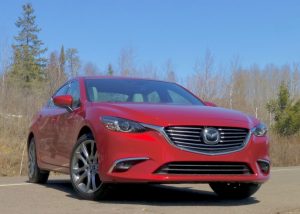
The Mazda6 always has had sporty lines, and the 2017.5 upgrade adds interior features and such functions as G-Vectoring.
If you had never seen the most recent version of the Mazda6 sedan, and got a chance to spend some time with a 2017 model, chances are you would be impressed at how such an impressive, state of the art sedan could have eluded your notice.
The Mazda6 is the small Japanese company’s flagship sedan, officially midsize in the same way that the Honda Accord, Toyota Camry, Nissan Altima, Volkswagen Passat, Ford Fusion and Chevrolet Malibu are midsizers.
I had not driven a 2017 Mazda6, although it always has been one of my favorite cars because of its tight handling, sporty performance and flashy appearance. Pretty hard to beat that trio of assets.
When I discussed some test drives upcoming, I asked if the distribution company happened to have any 2018 Mazda6es, and he said they hadn’t seen one, “but we have a 2017.5,” he said.
What I remember about the last Mazda6 I had driven, maybe a 2015 or 2016, was that the interior was basic and simple, which in contemporary vernacular means non-luxurious.
From an engineering standpoint, nobody matches Mazda’s dedication. Others are excellent, but in my opinion, Mazda is on top. The Skyactiv engine technology is just one of those features. A more recent one is the elaborate G-Vectoring technique to limit torque to the outside front wheel in tight cornering, virtually coaxing the driver to turn at the first moment he should.
The G-Vectoring was put in place on the CX-5 and the Mazda3 a year ago, but it missed this cycle of the Mazda6.
So what could knowing a new and improved Mazda6 is coming soon, to upgrade the present car — the 2017 model — to completely redo the interior, to slightly tweak the exterior, and to install the G-Vectoring to the Mazda6?
I had no idea what the 2017-and-a-half would look like, so I paid extra attention to it when it showed up from the Chicago press fleet. It was bright red, or, in Mazda terms, Soul Red Metallic. Mazda, it must be noted, has at least three different red colors for the exteriors of its cars and SUVs, with the newest one being exclusive to the CX-5 compact SUV. That is my favorite of the array of reds, but they all are attractive. The test car was the GT model, which means a few extra sporty touches.
This 2017.5 Mazda6 wears its paint well. On a sunny day, parked at the right angle, it picks up the rays of sunshine and puts them to use on every contour that graces the body. That makes all the well-designed contours meaningful, and gives the car a little extra appeal.
The beak of the nose is dramatic, sharply bringing together all those lines with a menacing opening, and the roofline flows back gracefully into an almost coupe-like shape that comes down to the rear hatch. That grille, incidentally, has shutters that open and close when you’re at highway speeds to aid the aerodynamics a bit.
Mazda has made a career out of providing “zoom-zoom” in its cars — a little added dash of sporty handling and pep. You can kiss that off as marketing, but there is no question Mazdas are fun to drive. With powertrains that are both quick and fuel-efficient, the zoom-zoom comes alive.
From marketing strategy, Mazda has done some fantastic engineering in recent years, including its Skyactiv engines that extracts all the available power fuel economy out of the Atkinson cycle’s delayed valve operation on the 2.5-liter 4-cylinder engine.
The numbers don’t convey street racing or drag racing, but they are misleading effective in swift travel, if you need it. There is 184 horsepower and 185 foot-pounds of torque, and with front-wheel drive you’re not going to get much tire-smoking wheelspin at those rates. The 6-speed automatic is wide-set in its ratios, which means you don’t get a drag-racer’s close-ratio shifts.
Instead, you can use the Sport-mode of the settings, and you can stand on the gas a little to get full spunk out of that engine.
It does challenge you as a driver, and it’s a real-world compromise. For most of your daily driving, the gearing is just right. You start up moderately and get to where you’re going efficiently. If you want a little dash, you shift into sport mode and step on the gas firmly, holding the revs as they build.
G-Vectoring is a race trick that causes you to develop and then obey your instincts for when to turn in sharply on a corner. It works in production cars to make normal street driving safer, because you don’t spend half of your turns correcting and then maybe over-correcting. You drive a Mazda6 with G-Vectoring and you don’t remark about how neat it feels; all you know is the car feels like it handles with better agility than you anticipate. If you’re really aware, yu mighjt remark about how you never seem to have to correct the steering wheel when you make a turn.
The seats are wide and supportive, and the interior is covered everywhere with softer surfaces. A lot of leather. Nappa leather, to be specific, parchment color. Heated front and rear seats.
You have extra control with paddle shifters, part of the GT image and a useful tool for any enthusiast driver.
With dynamic stability control and a traction control system with hill launch assist help you go in traffic, and four-wheel independent suspension works in harmony with stabilizer bars front and rear, and the whole package is aided by the latest electronic safety devices — Skyactiv body-rin safey structure, with cross-traffic and blind spot assists.
LED headlights and foglights also are high-tech touches, and automatic headlight control works well.
Altogether, the 2017.5 Mazda6 seems to be a technical, safety and creature-feature upgrade over the normal 2017 model, and the GT model has a base price of $30,000, with the add-ons boosting the as-tested price to $34,695.
With features you see and touch, that’s not too bad, and with things you can’t see, such as G-Vectoring, and Skyactiv powertrains, it’s pretty much a bargain. It does, however, make me wonder what the all-new 2018 model Mazda6 will be like when it reaches dealerships by early summer.


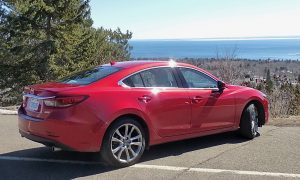
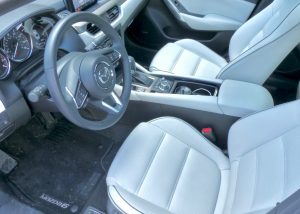
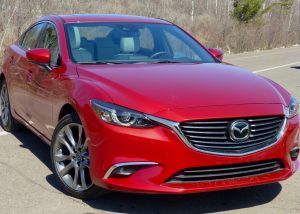
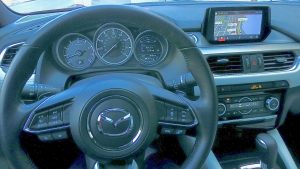
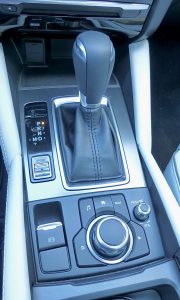
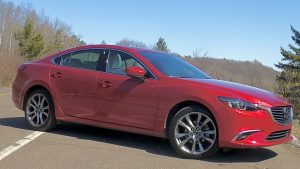
 John Gilbert is a lifetime Minnesotan and career journalist, specializing in cars and sports during and since spending 30 years at the Minneapolis Tribune, now the Star Tribune. More recently, he has continued translating the high-tech world of autos and sharing his passionate insights as a freelance writer/photographer/broadcaster. A member of the prestigious North American Car and Truck of the Year jury since 1993. John can be heard Monday-Friday from 9-11am on 610 KDAL(www.kdal610.com) on the "John Gilbert Show," and writes a column in the Duluth Reader.
John Gilbert is a lifetime Minnesotan and career journalist, specializing in cars and sports during and since spending 30 years at the Minneapolis Tribune, now the Star Tribune. More recently, he has continued translating the high-tech world of autos and sharing his passionate insights as a freelance writer/photographer/broadcaster. A member of the prestigious North American Car and Truck of the Year jury since 1993. John can be heard Monday-Friday from 9-11am on 610 KDAL(www.kdal610.com) on the "John Gilbert Show," and writes a column in the Duluth Reader.